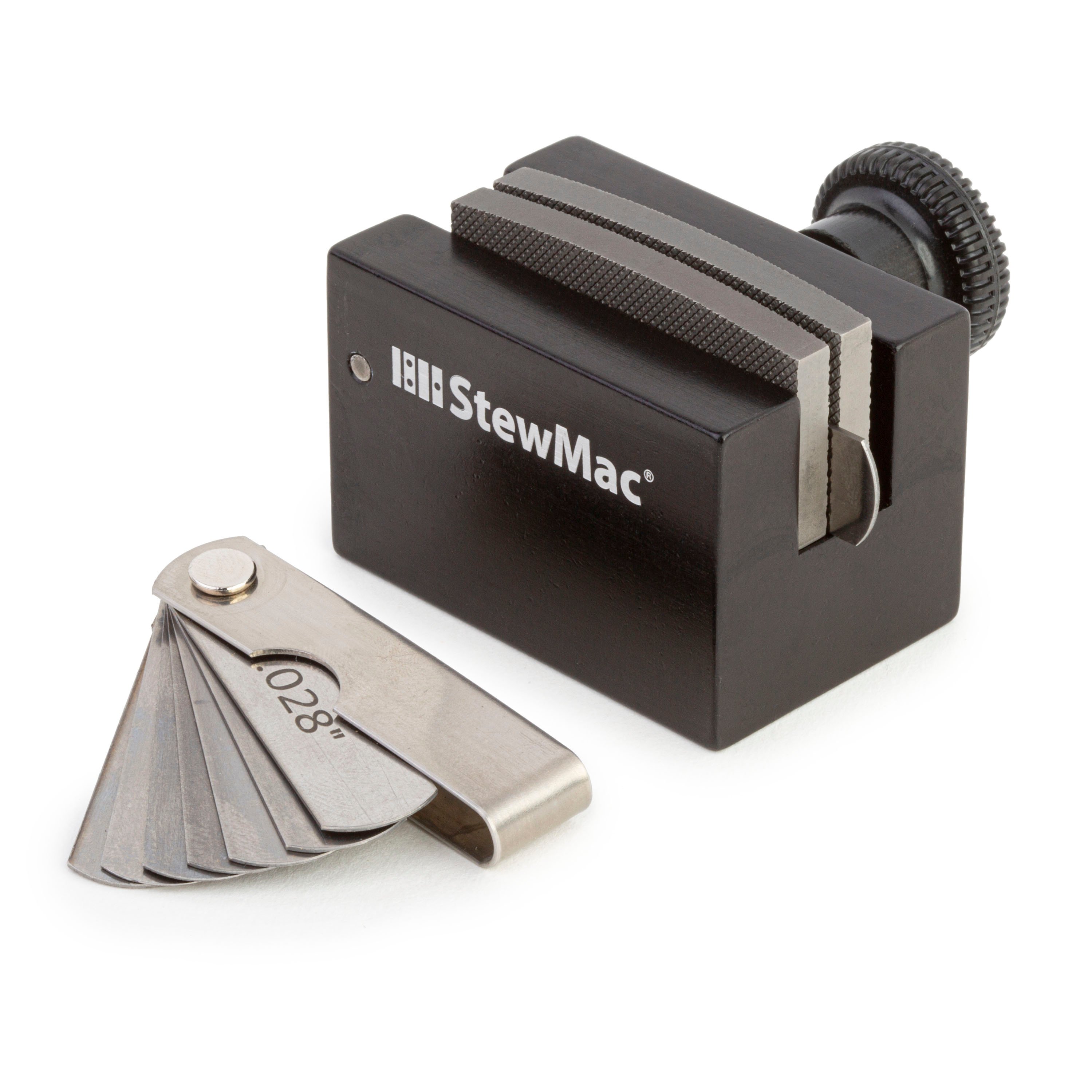Fret Barber Instructions
The Fret Barber lets you "take a little off the sides" to adjust the width of the fret tang by removing metal from the barbs.
The Fret Barber lets you "take a little off the sides" to adjust the width of the fret tang by removing metal from the barbs. This way, you can control how much force is needed to press the frets into the slot/ Even when the fret tang matches the width of the slot, the barbs can add enough mass to create more compression than you want. The pressure from this added metal, multiplied by the number of frets, sometimes is enough to force the neck into a back-bow. More often, it simply makes it hard to install the frets — especially with the harder rosewood and ebony fretboards. By sizing the fret tang, the Fret Barber can also help a back-bowed neck to "relax" into straightness or a controlled relief (slight upbow). The thinner tang allows each fret slot to close just enough to accomplish this. An acoustic guitar's fretboard extension over the body is a delicate place for fretwork. Whether you're hammering-in frets or pressing them in, this is an area where you'll want to use less force. Even when you're installing frets with full barbs in most of the neck, you may want to trim down the barbs for easy installation on the fretboard extension. With the frets removed, clean any residue from fret slot (our Fret Slot Cleaning Tool and Refret Saw are good slot cleaners). 1. Measure the fret slot with feeler gauges. Most guitars have slots of about .018" to .023" — the most common is .022". Fret tangs usually range from .021" to .024", so the tang is already a tight fit even without barbs — add the barbs, and the fit can be too tight. 2. Measure the barb-to-barb width. For these instructions, we'll use .036" — a common width for the outer barb-to-barb measurement. 3. Clamp the Fret Barber into a vise with the crossbar toward you. The teeth of the files (indicated by an arrow) should face away because you are going to pull the fretwire toward you, into the cut of the teeth. 4. Put a feeler gauge between the files. Rest it on the bottom of the block and tighten the set screw gently — just enough to hold the parts in place. 5. Grab the end of the fretwire with pliers or vise-grips. The fretwire can be either straight or radiused (the tops of the files are curved so that radiused fretwire can be used). 6. Press the tang between the files. Snug the setscrew to squeeze the files against the barbs. 7. With a gloved hand, press the fret wire down onto the files. With the vise-grips, pull the wire through the cutting teeth. Keep a gloved finger holding the fret crown against the file tops while you pull the wire through. When the setscrew tension is correct, you'll be pulling against some resistance as the barbs are filed down, but not enough resistance to make it difficult. Don't expect to do the cutting in a single pass. 8. Tighten the setscrew as you pull the wire through another time or two. The filing is done when the screw is tight and the fretwire glides through without resistance. Loosen the screw, remove the files and feeler gauge, and tap the powdered filings into the trash. (Don't blow it out of there, it'll scatter abrasive filings around your work area.) Repeat these steps, dropping down in size with the narrower feeler gauges, until the barb-to-barb measurement is in the range you want. To test the fit, trim a short (3/8") piece of the wire and tap it into a fret slot over the neck-body joint, where there's solid support. Pry up this piece to test the fit. It can be removed easily without harming the fret slot, and it gives a good indication of the snugness of the fit. Continue changing feeler gauges (proceeding in order — don't skip sizes) until you have the fit you like. In some cases, you may decide to file the fretwire down to the bare tang, eliminating the barbs entirely. You can do this quite accurately with the Fret Barber.
For the fretboard extension on acoustic guitars
Using the Fret Barber

